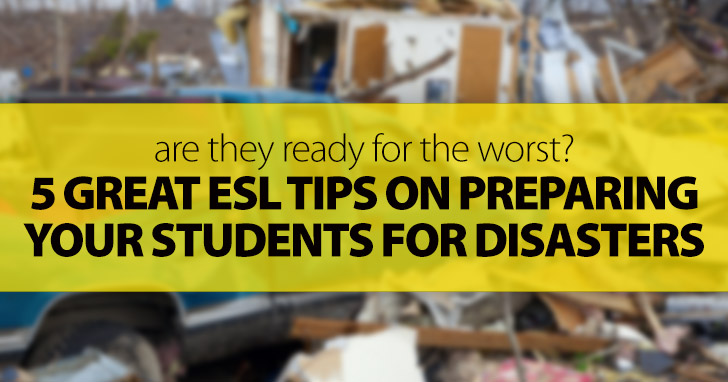Extreme weather events are everywhere.
Who hasn't been affected by one in one form or another? Whether it's extremely cold or hot, wet or dry, our weather conditions are changing drastically and bringing all sorts or unexpected chaos in its wake. Let's face it, these problems are here to stay. Now, facing difficult situations like these is certainly hard anywhere you are, but think about your ESL students who usually need to travel and might even live abroad at some point. Don't they deserve to be ready? If you consider that disasters of different sorts are more and more common, helping your ESL students for unexpected mishaps is very important. So the question is, how can you do this? Take a look at these tips.

Teach Students Where the Info Is
-
The first rule in any kind of preparation is info, info, info. The first thing your students will need to do is learn where they can find information about the disasters they might encounter. So a little research is required here but fortunately, there plenty of different sources of information. The main objective here is not only to find information but for them to learn how to search for that kind of information by themselves. Once they are on their own things could get a bit hairy if they aren't ready. Also since there are many sources of information on just about anything, it is necessary to check these sources ahead of time.
-
1
Sources of Info
Be sure to do a bit of research ahead of time so that by the time you have the lesson you are ready to guide your students to the best sources. Governmental organizations are usually very trustworthy but there are others as well. A bit of looking around will definitely help you find great info.

Teach about Disasters and What They Are About
-
So now that we know where the good information is, you are ready for the next step. First things first, what is a natural disaster? In this case you will need to learn about different kinds of disasters together and go over the information with your students.
-
2
A List of Disasters
Start with a list of some of the most common disasters. Of course there are different types so what you should focus on is names and general description of each. It is important to understand what the consequences of each type of disaster are. Ask yourself these questions. What happens when they hit? What do they do? What is the degree of destruction? Of course you can add to this list and remember the more info you cover, the more they will know.
-
3
Places for Disasters
Your students will not encounter all types of disasters. They might however bump into one or two depending on where they are traveling or moving to. After going over a list of common natural disasters, you should focus on where they happen. What types of disasters affect the place where they'll be. By doing this you can spend more time on the types of situations they will likely encounter.

Teach about the Ways of Reacting
-
OK, you have your sources, you know about disasters, some of their main characteristics and where they hit. What comes next? Well, just learning about possible problems isn't very useful unless you know what to do about them. So for this last part of the lesson, you should focus on what should be done when disasters come knocking at your door. Once again, you will find this info on the sites you consulted earlier.
-
4
Understanding Procedures
Make sure your students are ready to follow steps and fully understand what they need to do when something happens.
-
5
Knowing Expressions
Teach them expressions like take cover, evacuate, warning, emergency, etc. They are necessary for them to understand what they need to do. You will find much more vocabulary on the sites you are consulting. They should understand all of them clearly because there may be cases where their survival might depend on it.
Being ready can give people a fighting chance to get through hard situations unscathed.
However even though we are talking about disasters, we must always keep the lessons upbeat, goal oriented and positive. Keep in mind that we are preparing them for the worst but even in hard conditions we should always hope for the best.
P.S. If you enjoyed this article, please help spread it by clicking one of those sharing buttons below. And if you are interested in more, you should follow our Facebook page where we share more about creative, non-boring ways to teach English.







